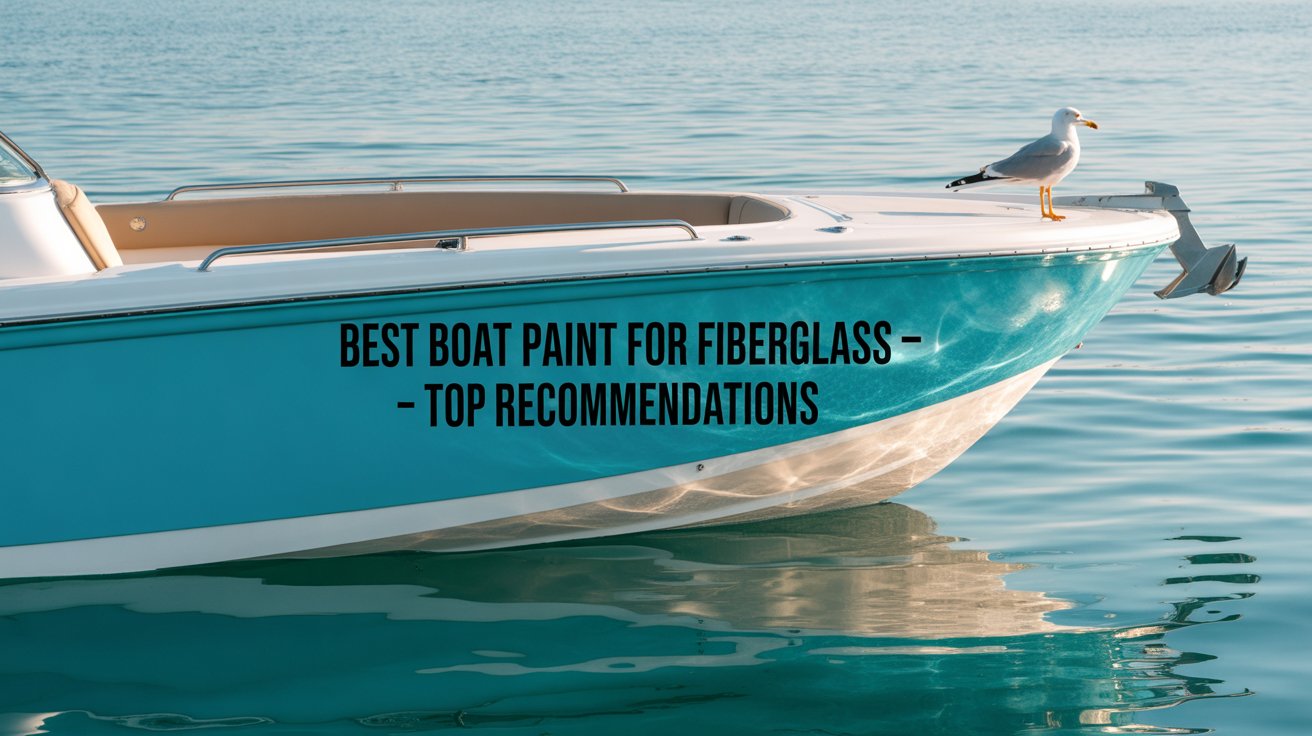Choosing the right boat paint is crucial for protecting your fiberglass vessel from the harsh marine environment and maintaining its aesthetic appeal. Whether you need topside paint for a gleaming finish, antifouling paint to prevent marine growth, or a non-skid coating for safety, this guide will help you navigate the options available and find the perfect paint for your needs. We’ve reviewed top-rated products to assist in your decision-making process.
1. TotalBoat

TotalBoat Wet Edge is a durable, high-gloss marine paint ideal for fiberglass, wood, and metal. Easy one-part application. Provides excellent scratch and chemical resistance. Resists fading, cracking, and peeling. Suitable for above-waterline use only. Durable, High-Gloss Finish Easy 1-Part Application Versatile Use Self-Leveling Finish Multiple Colors Available
Key Features
- Durable, High-Gloss Finish
- Easy 1-Part Application
- Versatile Use
- Self-Leveling Finish
- Multiple Colors Available
Pros
- Durable
- Easy to apply
- Glossy finish
- Good chemical resistance
Cons
- Not for underwater use
- Can be expensive
Best for: Above-waterline surfaces
Why buy: Provides a long-lasting, beautiful finish. Easy application for DIY projects.
2. Interlux Fiberglass Bottomkote NT

Interlux Fiberglass Bottomkote NT is a top-performing antifouling paint. Provides excellent protection against marine growth. Designed for use below the waterline. Long-lasting protection for your boat's hull. High-performance antifouling
Key Features
- High-performance antifouling
Pros
- Effective antifouling
- Long-lasting
Cons
- Expensive
- Requires proper surface preparation
Best for: Below-waterline protection
Why buy: Superior protection against marine growth. Keeps your boat hull clean and efficient.
3. TotalBoat Underdog Marine Antifouling

TotalBoat Underdog is an economical antifouling bottom paint. Provides single-season protection. Effective against barnacles and mussels. Durable finish withstands trailering and beaching. Suitable for various boat types. Economical Single-season protection Durable finish Easy application
Key Features
- Economical
- Single-season protection
- Durable finish
- Easy application
Pros
- Affordable
- Effective
- Easy to apply
Cons
- Single-season use
- May not be suitable for all conditions
Best for: Boats used frequently
Why buy: Cost-effective solution for seasonal protection. Easy to apply and maintain.
4. TotalBoat Marine Topside Boat

TotalBoat Topside Primer provides a durable base for topside paints. One-coat coverage for easy application. Cures to a smooth finish. Compatible with various topcoat types. Improves adhesion and paint longevity. Durable undercoat One-coat coverage Easy application Fast drying time
Key Features
- Durable undercoat
- One-coat coverage
- Easy application
- Fast drying time
Pros
- Durable
- Easy to apply
- Fast drying
Cons
- Not a topcoat
- Requires additional topcoat
Best for: Fiberglass and wood surfaces
Why buy: Ensures better adhesion and durability for your topside paint. Saves time with one-coat coverage.
5. TotalBoat-409322 TotalTread Non-Skid Deck

TotalBoat TotalTread is a durable, non-skid deck paint. Provides high traction and secure footing. Long-lasting polyurethane finish. Easy application. Available in multiple colors to match your boat. Non-skid surface Durable finish Easy application Multiple colors
Key Features
- Non-skid surface
- Durable finish
- Easy application
- Multiple colors
Pros
- Durable
- Non-slip
- Easy to apply
- Multiple color options
Cons
- Only for decks
- Can be more expensive than other paints
Best for: Boat decks and other high-traffic areas
Why buy: Ensures safety and prevents slips. Provides a long-lasting, attractive finish.
6. Rust-Oleum Available 207012 Marine

Rust-Oleum Marine Flat Boat Bottom Antifouling Enamel Paint effectively prevents fouling below the waterline. Formulated to slowly release copper to deter marine growth. Easy to recoat, launch in 16 hours. Covers up to 110 sq ft. Antifouling Copper-based Fast drying Good coverage
Key Features
- Antifouling
- Copper-based
- Fast drying
- Good coverage
Pros
- Effective
- Fast drying
- Good coverage
Cons
- May not be suitable for all surfaces
- Contains copper
Best for: Mild to moderate fouling conditions
Why buy: Provides reliable protection against marine growth. Quick drying time allows for rapid relaunch.
7. SENVEN Boat Paint

SENVEN Boat Paint is an all-in-one option for topside, bottom, and waterline. High-gloss finish for exceptional durability. Adheres well to fiberglass, wood, and metal. Resists abrasions and extreme weather. All-in-one use High-gloss finish Durable Abrasion-resistant
Key Features
- All-in-one use
- High-gloss finish
- Durable
- Abrasion-resistant
Pros
- Versatile
- Durable
- Easy to apply
Cons
- May not be as specialized as other paints
- Limited color options
Best for: General-purpose boat painting
Why buy: Convenience of a single paint for multiple applications. Provides a durable and attractive finish.
8. TotalBoat Krypton Copper Free

TotalBoat Krypton Copper Free Antifouling Bottom Paint offers superior protection. Copper-free formula prevents corrosion. Suitable for various boat types, including aluminum. Easy application and no maximum dry time before launch. High-performance Copper-free Versatile Easy application
Key Features
- High-performance
- Copper-free
- Versatile
- Easy application
Pros
- Effective
- Copper-free
- Easy to apply
- No maximum dry time before launch
Cons
- Relatively expensive
- May require more coats
Best for: Aluminum and other metal boats
Why buy: Environmentally friendly and corrosion-resistant. Excellent protection against marine growth.
9. TotalBoat JD Select Ablative

TotalBoat JD Select Ablative Antifouling Bottom Paint provides full-season protection. Self-polishing coating minimizes buildup. Low odor and easy cleanup. Easy application with brush, roller, or spray. Suitable for various boat types. Full-season protection Self-polishing Low odor Easy application
Key Features
- Full-season protection
- Self-polishing
- Low odor
- Easy application
Pros
- Effective
- Low odor
- Easy to apply
- Minimizes buildup
Cons
- More expensive than some alternatives
- Limited color options
Best for: Boats in salt or freshwater
Why buy: Provides excellent antifouling protection with minimal buildup. Easy to apply and clean.
10. SENVEN Boat Paint

SENVEN Boat Paint Touch Up Pen is ideal for small repairs. High-gloss finish blends seamlessly. Easy to use with built-in brush. Water-based formula for low odor and easy cleanup. Suitable for various surfaces. Touch-up pen High-gloss finish Easy application Water-based
Key Features
- Touch-up pen
- High-gloss finish
- Easy application
- Water-based
Pros
- Convenient
- Easy to use
- Low odor
- Good for small repairs
Cons
- Limited quantity
- Not suitable for large areas
Best for: Small scratches and chips
Why buy: Perfect for quick repairs and touch-ups. Saves time and money compared to repainting entire sections.
Buying Guide: Choosing the Best Best boat paint for fiberglass
Selecting the best boat paint involves considering several factors. First, identify the area you’ll be painting. Topside paints are designed for above-the-waterline surfaces, providing a durable and aesthetically pleasing finish. They often prioritize UV resistance and gloss retention. In contrast, antifouling paints are specifically formulated for below-the-waterline application to prevent barnacle and algae buildup. These typically contain biocides to deter marine growth. Finally, non-skid paints are essential for deck surfaces to provide traction and prevent slips.
Next, consider the type of paint. One-part paints are generally easier to apply and require less preparation. Two-part paints, while requiring more careful mixing and application, often offer superior durability and longevity. The paint’s composition also matters; polyurethane paints tend to provide a harder, more durable finish than acrylic paints, which are often easier to clean and have less odor. Finally, consider the application method. Some paints are better suited for brushing, while others are ideal for spraying, allowing for a smoother and more even coat.
Finally, always read the manufacturer’s instructions carefully before starting your project. Proper surface preparation, including cleaning and priming, is vital for ensuring a long-lasting and effective paint job. Consider factors like the size of your boat and the amount of paint needed to complete the job. Remember to work in a well-ventilated area, wear appropriate safety gear, and dispose of any waste responsibly. Choosing the correct paint and following application instructions ensures the protection and beauty of your boat for years to come.
Prepare the surface well: clean, fill dents, sand lightly, and use a bonding primer where needed. Good prep is 70% of the result.
Choose the right finish for the room: matte hides flaws, satin balances look/durability, semi-gloss is most wipeable for kitchens/baths.
FAQs
How often should I repaint my fiberglass boat?
The frequency of repainting depends on the type of paint used, environmental factors, and usage. Topside paints may last several years, while antifouling paints typically require annual applications.
What is the best way to prepare the surface before painting?
Thorough cleaning, sanding, and priming are essential. Remove any dirt, grime, old paint, and loose material. Sanding ensures a smooth surface for better paint adhesion. A primer provides a uniform base for the topcoat.
Can I use topside paint below the waterline?
No. Topside paints are not designed for underwater use and will not provide effective protection against marine growth.
What is the difference between ablative and hard antifouling paints?
Ablative paints gradually wear away, minimizing buildup. Hard paints remain on the hull, requiring more frequent cleaning and potential removal.
What safety precautions should I take when painting my boat?
Always work in a well-ventilated area, wear appropriate safety gear (gloves, mask, eye protection), and follow the manufacturer’s safety instructions.
How much paint do I need?
Calculate the surface area to be painted and refer to the paint’s coverage information (usually sq. ft. per gallon or quart) to determine the necessary quantity.
Conclusion
Selecting the right boat paint can significantly enhance your boating experience. By carefully considering your specific needs, surface type, desired finish and application method, you can find the perfect product to keep your fiberglass boat looking its best and protected from the elements. Remember, proper preparation and application are key to achieving a long-lasting result.
Disclosure: As an Amazon Associate we earn from qualifying purchases. Prices change frequently; confirm on Amazon.

